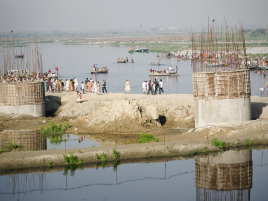Campaign Against Yamuna Overpass Continues
By Madhava Smullen | May 17, 2010

In Braj, India, the area where Lord Krishna appeared and performed His pastimes 5,000 years ago, a lengthy court battle over a new highway overpass on the sacred Yamuna River continues to rage.
Locals raised a cry of outrage in November 2009, when construction began on the overpass, a “half-moon flyover” bridge connecting the Parikrama Marg (pilgrimage path) on one side of the sacred Keshi ghat bathing area to the path on its opposite side. The bridge was even planned to run parallel to and directly in front of Keshi ghat for some distance.
In retaliation, the Vrindavan Yamuna Heritage Foundation sprang up in December 2009 to stop the bridge and to create alternative development plans for Vrindavana that would respect its vast spiritual and historical heritage. At the forefront of the organization were spokespeople Chandan Goswami, of Vrindavana’s ancient Radha Ramana temple, and retired Indian Police Service officer and national anti-terrorism hero KPS Gill.
Another group, comprising of local citizens, NGOs, institutions and other Vrindavana stakeholders and dubbed the Braj Vrindavan Heritage Alliance, formed in January 2010. Headed up by Chandan Goswami and his father Shrivatsa Goswami, it is currently campaigning to have Braj—and especially Vrindavan, the village where Krishna was born—declared a UNESCO World Heritage Site.
“These groups are against the bridge because its design and placement are arbitrary and unnecessary,” says Katie Walter, a Fulbright student researcher conducting surveys with residents and pilgrims about Vrindavan conservation issues. “If it goes up, the iconic view of Keshi ghat from the Yamuna will be permanently destroyed. Added noise and air pollution at the ghats will result, as will additional garbage thrown from vehicles and highway runoff pollution. Already, the sediment and rubble dumped in the Yamuna to be used as a building platform is trapping sewage at the ghats. And all this for a bridge that runs in the river longer than absolutely necessary to facilitate sensible transport.”
Soon after these groups were founded, the High Court at Allahabad ordered a halt on all construction work at the Yamuna, finding it to be in violation of the Indian Archeological Act and the Environment Protection Act. However a second hearing in February was postponed and the judge who had given the order was suspended. In March, the new judge re-approved the construction.
Now, however, reports are saying that this judgment lifting the construction ban was not based on the half-moon flyover plan that is being executed and that was submitted to the judge, but on non-existent plans of the bridge crossing the Yamuna. The blunder, which sources say was made by the judge because of the great deal of pressure he was under, leaves the door wide open for the case to be taken to another court.
As a result, there is a new public interest litigation petition which calls for the clearing of all construction waste from the area, while lawyers defending the Yamuna aim to file a caveat in the Supreme Court to regain and protect the former injunction, which banned any construction along Vrindavan ghats and in Mathura.
“We are also told that Jaypee Construction, the company building the bridge, is hurting for funding as it tries to complete the massive Yamuna Expressway group of projects,” Katie says. “It is said that their payments to subcontractors are in arrears and that they are demanding three Crores of rupees from the state to restart work on the bridge. The state is not willing to do this, so construction continues to remain at a standstill for now.”
Adding further obstacles to the construction of the bridge is an update to the Ancient Monuments and Archaeological Remains Act of 1958 passed in parliament last month, which forbids any construction within 300 meters of an Archaeological Survey of India (ASI) protected monument.
“The bridge is currently situated 107 meters from Jugal Kishore Mandir,” says Katie. “Before the new amendment, projects could get clearance from regional and national ASI offices by obtaining a No Objection Certificate (NOC). This process has now been completely done away with. Furthermore, no new constructions are allowed to take place at all until all pertinent bylaws to this amendment have been formulated. The director of ASI, people in the Architectural Heritage Department of INTACH and others have expressed the view that since this bridge has not yet been built, it will not be allowed to be fully constructed in light of this new law.”
Keshi ghat and Jugal Kishore Mandir are not alone in being attacked by unsightly developments. According to the Press Trust of India, a total of 249 centrally-protected monuments and archaeological remains in the country have been encroached upon—with 79 of these in the state of Uttar Pradesh, where Braj is located.
It is expected that the Yamuna case will be taken all the way to the Supreme Court. Meanwhile, the international community can make their voices heard by signing the online petitions available at www.bvhalliance.org (Although this is not recommended for those residing in India or planning to travel there soon, as they may encounter visa problems as a result.). They can also help Vrindavana organizations, a list of which can be found under the supporters’ link at bvhalliance.org, by volunteering services or donating money.
“Locals also suggest that foreigners solicit NGOs to see if they will help prepare sustainable development plans for Vrindavan, and then write a letter of concern to the Indian embassies in the U.S.detailing such NGO support,” says Katie Walter. “Remember while offering your much appreciated help, though, that foreigners have been cautioned strongly not to actively demonstrate against the bridge—and of course antagonism has been unequivocally discouraged in this campaign.”
To keep up to date on the status of the Yamuna case, please visit the Facebook page Save Yamuna to Save Vrindavan!.















